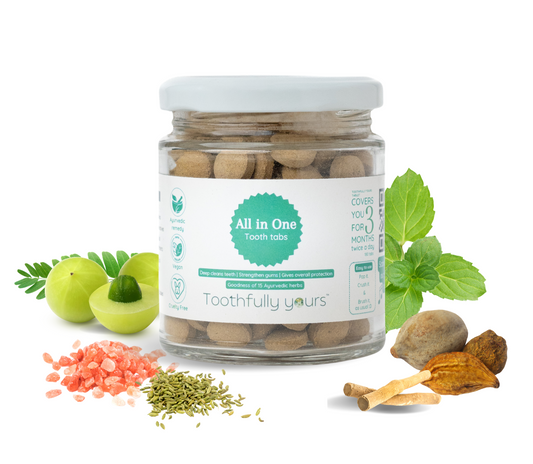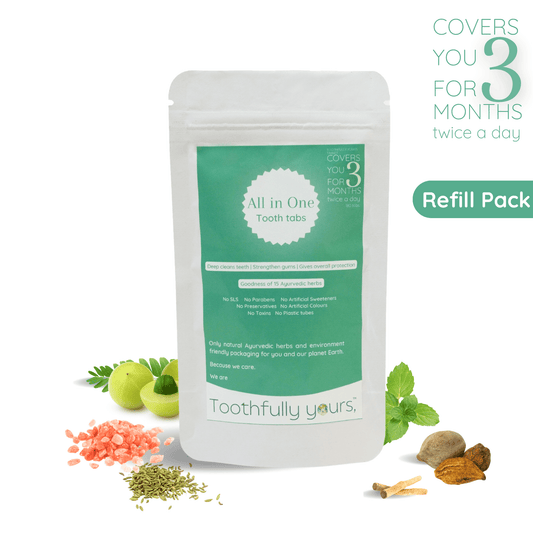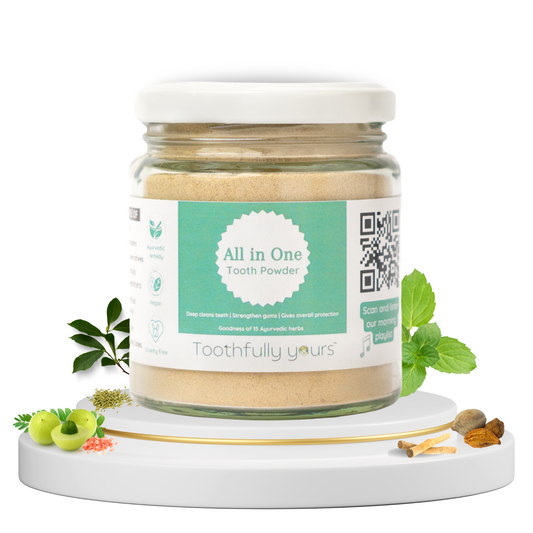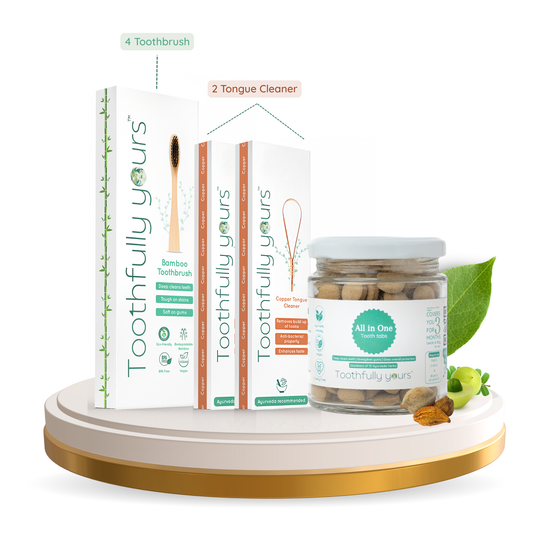
Why there is SLS in toothpaste!? And how to avoid it.
Sodium Lauryl Sulphate (SLS) is a commonly used surfactant found in numerous personal care products, including shampoos, soaps, body washes, facial cleansers, and toothpastes. SLS is only added for its effective foaming action, which creates a perception of cleaning and a sense of satisfaction, all thanks to multibillion-dollar advertisements shown to us throughout many decades. SLS has come under scrutiny due to concerns about its potential harmful effects on oral health and overall well-being due to its skin-irritating nature and impurities found in it.
Specific to oral care, research has raised concerns about the potential harmful effects of SLS on oral health. One significant concern is SLS's ability to cause irritation and sensitivity in the mouth, leading to the development of canker sores and mouth ulcers in some individuals. Additionally, SLS may strip away the protective layer of mucus in the mouth, potentially leaving the gums more susceptible to inflammation and irritation.
Moreover, studies have indicated that SLS can disrupt the delicate balance of the oral microbiota, leading to an imbalance of beneficial and harmful bacteria. This imbalance may contribute to gum disease and other oral health issues. Some research has also suggested a link between SLS and dry mouth, which can further impact oral health and comfort.
SLS can appear on product labels under different trade names, including Sodium Dodecyl Sulphate (SDS), Sodium Lauryl Sulphate Ethoxy (SLES), and Sodium Laureth Sulphate (SLES). These alternative names are used interchangeably and may be found in various personal care products, including toothpaste.
The biggest irony is that when the market is flooded with SLS-free shampoo, face wash, and body wash, how come toothpaste, which goes in the consumer's mouth, can have SLS in it? In many cases, the SLS-free shampoo and toothpaste with SLS in them have the same multinational brand! How can a chemical that is avoided in skin or hair care products be safe to put in our mouth?
Due to increased awareness, there are growing concerns about SLS’ potential side effects, which have led many consumers to seek alternatives, be they SLS-free shampoo or SLS-free toothpaste. For those who prioritise oral health and seek a more natural approach to oral care, SLS-free toothpaste is becoming their top priority. But as the market is still nascent, there is a dearth of SLS-free oral care products on the market.
To solve this particular issue of toxic chemicals in oral care products, we took it as a challenge and developed the safest oral care for you and our planet Earth. We read Ayurvedic texts to understand which techniques and ingredients are mentioned for solving particular issues in the oral cavity and maintaining oral hygiene. And with the purpose of developing the cleanest product, we purposely chose not to make another toothpaste and developed a tooth tab. As toothpaste contains 40% water, we have to add preservatives; hence, we developed tooth tabs so that we can avoid all such chemicals.
Our first product, All-in-One Tooth Tabs, is the perfect solution for your search for SLS-free toothpaste. It has 15 highly effective ayurvedic herbs like Triphala, Miswak, Babool, and Neem, to name a few, that work on various aspects of oral hygiene, from deep cleaning teeth and removing plaque to soothing gum inflammation and keeping gums healthy. Visit this page to view all the ingredients in our product.
How do we use our tooth tabs?
Very easy. Just pop it, crush it, and brush it as usual. After crushing our tabs, our tab mixes with your saliva and is ready to clean your teeth and keep your gums healthy.
End your search for SLS-free toothpaste with us, so that you can avoid all such toxic chemicals and keep yourself and your family healthy.
Only natural ingredients and plastic-free packaging are for you.
Because we care.
We are
Toothfully yours,
Reference links:
https://madesafe.org/blogs/viewpoint/chemical-profile-dioxane
Specific to oral care, research has raised concerns about the potential harmful effects of SLS on oral health. One significant concern is SLS's ability to cause irritation and sensitivity in the mouth, leading to the development of canker sores and mouth ulcers in some individuals. Additionally, SLS may strip away the protective layer of mucus in the mouth, potentially leaving the gums more susceptible to inflammation and irritation.
Moreover, studies have indicated that SLS can disrupt the delicate balance of the oral microbiota, leading to an imbalance of beneficial and harmful bacteria. This imbalance may contribute to gum disease and other oral health issues. Some research has also suggested a link between SLS and dry mouth, which can further impact oral health and comfort.
SLS can appear on product labels under different trade names, including Sodium Dodecyl Sulphate (SDS), Sodium Lauryl Sulphate Ethoxy (SLES), and Sodium Laureth Sulphate (SLES). These alternative names are used interchangeably and may be found in various personal care products, including toothpaste.
The biggest irony is that when the market is flooded with SLS-free shampoo, face wash, and body wash, how come toothpaste, which goes in the consumer's mouth, can have SLS in it? In many cases, the SLS-free shampoo and toothpaste with SLS in them have the same multinational brand! How can a chemical that is avoided in skin or hair care products be safe to put in our mouth?
Due to increased awareness, there are growing concerns about SLS’ potential side effects, which have led many consumers to seek alternatives, be they SLS-free shampoo or SLS-free toothpaste. For those who prioritise oral health and seek a more natural approach to oral care, SLS-free toothpaste is becoming their top priority. But as the market is still nascent, there is a dearth of SLS-free oral care products on the market.
To solve this particular issue of toxic chemicals in oral care products, we took it as a challenge and developed the safest oral care for you and our planet Earth. We read Ayurvedic texts to understand which techniques and ingredients are mentioned for solving particular issues in the oral cavity and maintaining oral hygiene. And with the purpose of developing the cleanest product, we purposely chose not to make another toothpaste and developed a tooth tab. As toothpaste contains 40% water, we have to add preservatives; hence, we developed tooth tabs so that we can avoid all such chemicals.
Our first product, All-in-One Tooth Tabs, is the perfect solution for your search for SLS-free toothpaste. It has 15 highly effective ayurvedic herbs like Triphala, Miswak, Babool, and Neem, to name a few, that work on various aspects of oral hygiene, from deep cleaning teeth and removing plaque to soothing gum inflammation and keeping gums healthy. Visit this page to view all the ingredients in our product.
How do we use our tooth tabs?
Very easy. Just pop it, crush it, and brush it as usual. After crushing our tabs, our tab mixes with your saliva and is ready to clean your teeth and keep your gums healthy.
End your search for SLS-free toothpaste with us, so that you can avoid all such toxic chemicals and keep yourself and your family healthy.
Only natural ingredients and plastic-free packaging are for you.
Because we care.
We are
Toothfully yours,
Reference links:
https://madesafe.org/blogs/viewpoint/chemical-profile-dioxane





